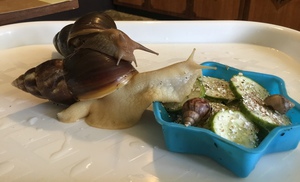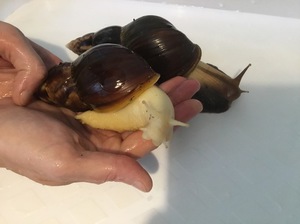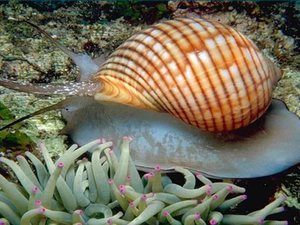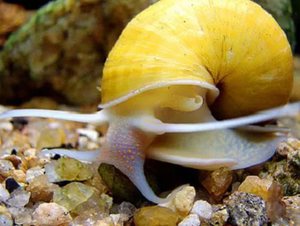Who has not found these sluggish babies in the grass, in the woods, in the country or even in town? The clams are distributed practically all over the globe. But most people have seen individuals with a small standard brown color of the shell.

In fact, species of snails are numerous. And the amazing thing is that they can be kept as exotic pet.
The species of snails
In the General sense, all snails can be divided into two large groups: land and water. The latter are divided into freshwater and marine. And those and others can be diluted at home. Especially, this kind of animal will suit busy people who have no opportunity to devote much time to the pet.

Most individuals are not too demanding in terms of content. However, there are more complex types. The most popular and unpretentious will be presented in this article.
Sea snail
Marine birds there are more than 50,000 species. Colouring and form of the shell they are much brighter fresh-water and terrestrial counterparts. Kind of all snails are divided into herbivorous, planktivorous and carnivorous. The latter is often devour their neighbors and they need to be careful.

Contain the sea snails in home aquariums, along with fish and plants. In addition to aesthetic enjoyment, aquatic molluscs make an invaluable contribution in the biobalance of the aquarium.
They eat harmful algae and filter the water.
One of the most popular and useful types are the following:
- Trochus. This clam shell has beautiful, reminiscent of the spiral pyramid. Unique algae eater and a scavenger of cyanobacteria in a completely new aquarium. It can grow up to 15 cm, and has a color from dark grey to blue-purple. Peaceful snail that won’t harm the rest of the invertebrates. All day this cleaner absorbs harmful micro algae and extra food is not needed. May dwell among the coral reefs, and thickets of plants, and soil.
- Turbo. Likes to hide in caves, occasionally creeping in search of food, and most of all they are active at night. Like the previous species, this sea dweller is an excellent cleaner. However, the size of the turbo is inferior, reaching only 5 cm in addition, the water for its contents should monitor the level of calcium, because it is needed for a strong shell. These snails it is recommended to feed dried algae and not overpopulate the aquarium, because the turbo can suffer from a lack of food.
- Snail nassarius. Baby can grow only to 1.5-2 cm Nassarius lives in the sand to the sea and has a completely unique properties. She has a special organ, the siphon, which it will examine the bottom in search of the smell of dead fish or shellfish. To do this, she completely buries himself in the sand, and when you smell coveted fragrance, aim for the prey to outrun the competitors. Thus, the snail cleans the bottom from the harmful substances released dead animals.
- The conch. Another incredibly useful clam. Externally it is oblong, gray-brown shell is not too beautiful and the conch will become a decoration for the aquarium. In addition, this medium size snail most of the time in sandy soil, sometimes not appearing on the surface for weeks. However, the occupant loosens the sand, not allowing it to sour and stagnate. Ideal for reef aquarium.
Freshwater snails
As the name implies, they complement freshwater aquariums. Popular snails of this species only a few can be called bright and colorful.

Still, molluscs serve more for use than for decoration.
- Ampulyarii snail or Apple snail. This kind of relates to decorative. Ampulyarii on average can achieve 5 cm In nature, their color varies from light to dark brown, and derived types can be of different colors. The most famous is the yellow albino ampulyarii, there are also pink, purple, white and even striped. These beauties are not picky about temperature and other water parameters, and is also actively working, eating algae and decaying plants.
- Snail chromeline. Has large spiky shell with lots of swirls and grows to 10 cm and Distinguishes it from simple Melania bright yellow body. These individuals are agressive to other inhabitants of the aquarium and care for them more complex. The water temperature should be 28 degrees, and the average stiffness. Under other circumstances, individuals become lethargic and inactive.
- Snail coil. Not all attribute it to decorative types, because bright color has and into the aquarium, often by chance, with the new plants. However, this is a fairly large species, with caramel-brown or red shell, which is also interesting to watch. It is found in most tropical freshwater aquariums and adapts to a wide range of temperatures and various water parameters. As the cleaner is universal and does not require additional feeding.
Land snails. Achatina giant African snail
If aquarium snails many have long been accustomed, the contents of the ground specimens in the terrarium are quite exotic.

There are several types of land snails, which include, in particular, the African and the new Zealand carnivorous snails, but the detail should describe the types of Achatina and archachatina because most home clam belong to him.
Clams reach an average of 12 cm, but the largest member of this genus reached 37 see They are particularly prolific, because one individual can lay up to 500 eggs. If you do not want to have a whole snail farm, you need to ensure that Pets are not left laying. Types of snails of the genus Achatina differ in shape, size and color.
But the conditions for them are about the same: need a cage with a good layer of excavation of soil about 5 cm below the snail can dig. The soil should be maintained slightly damp. The temperature inside the terrarium should be around 25-28 degrees, and the backlight is not required. Land snails eat lettuce, apples, leaves from trees, berries and bananas. You can also give bread and cereal.
The most beautiful specimens of this kind are:
- Achatina Fulica. Large variety with a shell up to 20 cm Shell has the shape of a cone, and can vary in color from light brown to a dark green shade. A prolific species, which can lay up to 700 eggs a few times a month.
- Achatina was irately or lemon. Very interesting view, which is not only small in size 5-7 cm, but also a form of reproduction. This snail is viviparous and mating of 2 individuals alternately assume the roles of the males, then females. Born at one time, about 20-25 of the little snails.
- Achatina of reticular. Marble coloration with a pattern of dots and stripes, as well as light body identifies the snail from the rest. In addition, she is very active and not too delicate – it can be ironed directly on rozhkam and they can not hide. Size can reach 20 cm.
Snails of the genus archachatina not much different in care from Achatina. However, it has its own peculiarities. Archachatina in need of protein feeding in the form of Daphnia or gammarus crustacean. In addition, the terrarium should add moss and oak leaves. Behavior they are more sluggish than Achatina, but can be very sociable, if often take. In size they are slightly smaller, averaging 12-15 cm.
Among the most interesting types include:
- Archachatina paulite. A large specimen that grows up to 12 cm. Her sink is various warm shades of brown, olive and beige. At a young age the body is milky-white, the shell emerges a distinct speckles.
- Archachatina of marginata. Clam has a beige shell with a pronounced pattern of dark bands. Incredibly beautiful color can complement the white body species, often occurring in subspecies owumi.
- Archachatina Adelina. Very whimsical, which is hard to domesticate. Usually sell snails caught in the wild and many of them in the cage to die. However, the lucky few that were able to grow, will get clam, very rare color. They have a blue-gray horns and light yellow shell covered with wavy dark lines or white with black stripes.
Snails are exotic Pets that can entertain without requiring special attention. They do not cause allergies in humans and is suitable for almost everyone. The main thing to remember about some peculiarities of each species and then their content will be a joy.



Marine birds there are more than 50,000 species. Colouring and form of the shell they are much brighter fresh-water and terrestrial counterparts. Kind of all snails are divided into herbivorous, planktivorous and carnivorous. The latter is often devour their neighbors and they need to be careful.